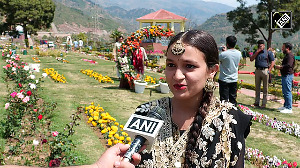When Sachin Tendulkar was bowled out for a duck by CDR Fernando during the India-Sri Lanka World Cup match, he didn't just destroy the hopes of a cricket-mad nation. Echoing the groans were advertisers and marketers who have pumped in more than Rs 500 crore (Rs 5 billion) into the Cricket World Cup.
The jury is still out on the extent of losses incurred by advertisers and broadcasters due to India's exit from the World Cup, much earlier than anticipated. Meanwhile, the strategist spoke to experts on how sports advertisers can play better strokes and mitigate risks
Associations with sports must always be planned carefully. Take the case of Shell, which sponsored the Ferrari team in Formula 1. Since Ferrari ran on Shell's fuel there was a clear association.
Brand ambassador Michael Schumacher also had a positive rub off on the brand. It was an association between a great car manufacturer, a great driver and a great fuel company. There was a clear link. But that is an ideal case and generally, you need to be really lucky when it comes to association with sports.
The trouble in India is, companies don't follow any branding principles. Some time earlier, Airtel's brand ambassadors included Sachin Tendulkar, Shah Rukh Khan and Kareena Kapoor.
Today, Reliance Telecom features Tendulkar in its ads. In India, brands and endorsers have neither a connection nor a long-term relationship.
Every four years, at Cricket World Cup time, companies spend large sums of money, sign on cricketers, carpet bomb ads and hope sales improve. But this is guess work marketing. Good companies always choose their sports and celebrities carefully. Nike and basketball star Michael Jordan would be a good example.
Of course, even globally, advertising behind sports is not working. Consider the Super Bowl in the US, for instance. Super Bowl advertising is very expensive: people spend huge sums for every second. But study after study shows that customers do not remember brands that are advertised during the event. There is a lesson here: Don't just jump on a sport. It won't deliver value and will be commercial suicide.
I have a fundamental issue with cricket-backed advertising. Studies show that customers in metros want to be associated more with tennis, golf, soccer and F1 racing. Cricket should be used only by mass market or FMCG brands that work on the value-for-money promise. For others, how much of the money spent will translate into sales or value to business is questionable.
Hero Honda is a case in point. The brand has advertised with cricket for many years now. But have its sales increased? Earlier, it had an unassailable lead over Bajaj. But today Hero Honda's margins, market share, targets are under pressure. Cricket has become a crutch that marketers can't seem to walk without but will have to discard if they are to run.
Cricket, its travails and tribulations have ruled headlines in the last few days. It is best to look at examples of good sports marketing from outside the immediate realm of cricket.
Look at the highly planned and disciplined manner in which Lenovo has built its global brand, riding the goodwill of the Olympic Games. Lenovo was originally branded Legend and it was, at best, a local Chinese brand that had global ambitions. The company started its association with the Olympic Games when preparations began for the Athens Games, by becoming a technology provider and partner.
The association was then built-up and Lenovo became the first ever Olympic partner brand from China. This coincided with Legend re-branding itself as Lenovo, apart from buying out the global IBM PC business, including the ThinkPad brand. Along the way, Lenovo played high stakes with Ronaldinho in the FIFA World Cup soccer and now it has lined up huge investments for Olympics 2008 in Beijing.
Lenovo has had a clear decade-long roadmap of global plans for the brand and has paced its association with relevant sports to grow its global equity, timed to brand-name change, international acquisitions and growing global ambitions. The Olympic Games have been used as a brand booster, a truly global platform from which the brand can speak to the world.
This is also the path many large Japanese brands have taken. Brands like Panasonic and Seiko are known for having consistently and diligently invested behind the Olympic Games to give them a global aura and to connect with sport at its noblest.
In India, we are still learning to handle investments in sports. Brands either go for an over-kill or they tend to do things half-heartedly. Just signing-up a sports star in a one-off commercial will never enrich a brand's equity. At the same, time building a humongous 360-degree exercise where you put all your efforts behind an event or sport can back-fire.
Use sports with the right balance, both strategically and tactically. Some brands build equity, and then strangely give it up. Britannia ruled the cricket scene till the last World Cup.
At present, all you see of the brand is its logo on the bats of some players. That kind of investment is neither here nor there. Of course, the other extreme of Pepsi's blue billion and exaggerated creative renditions turning cricketers into winning tigers can also be counter-productive when things go wrong.
Is there a fit between the brand and the World Cup? It's a very basic question that many marketers seem to miss. It may be too tempting for brands to jump onto the World Cup bandwagon, but it is critical to not overlook the fit.
Some product categories are just not suited for advertising in and around such big-ticket events - they could do more harm than good.
After the fit, one needs to consider brand life-cycle and thus, what does the brand seek to achieve through the association? Brands in early phases of their life cycle seek to gain increased awareness through World Cup-related promotions.
New brands are disadvantaged to the extent that they need to invest at disproportionately higher levels (compared to more established brands) to break clutter and gain increments in awareness.
For mature brands, the challenge is different - the marketing task is more image- and loyalty-oriented. Here, it makes sense to associate closely with the event, if possible through sponsorship, so as to get the desired changes in audience attitudes.
Speaking of closeness of association, great risks (and obviously the possibility of great returns) are involved for marketers when the brand is very closely associated with cricketers, rather than the event.
Pepsi, being endorsed by key cricket "tigers", was faced with the burning of its logos and posters when team India lost its match against Bangladesh. Tata Sky, which has used a non-cricket celebrity for its promotion, has managed to extract a lot out of a mild association with the event, at the same time insulating itself from such negative outbursts as Pepsi witnessed. It is important for the brand not to be seen as taking over the event.
In terms of the nature of campaigns, the World Cup gives an opportunity like none other for marketers to push the creative boundaries that they would normally adhere to in regular television viewing environments.
Ads that celebrate the spirit of the game or the event (say, Nike) are perhaps most appreciated by core cricket viewers. Contests offering tickets to winners (Britannia, for instance) have worked well in the past.
But with every other marketer using a form of this approach, it can no more be regarded as innovative or clutter-breaking. Celebrity ads will have a high decay. Ultimately, the success of any World Cup-related marketing campaign will be determined by how well it is integrated into the brand's on-going marketing activities, especially after the event.
In such a case as Team India's early exit, no amount of marketing craft can rescue the falling effectiveness of World Cup campaigns. Such is life! Better luck in 2011!
Most sporting events with celebrities grab the attention of viewers, especially when the sport is a part of a social culture, like cricket and films being a part of the Indian culture, despite the presence of diverse sub-cultures. Creating awareness about a new service, concept or product generates higher levels of interest among the consumers, and retailing arrangements are required as a follow up. Unless the brand is prepared for this follow up, it loses the advantage of being associated with the event.
But any sales promotion has to be synergised with the longer objective of the overall brand strategy. For instance, a brand like Nike may use the opportunity to strengthen its brand association with sports as this will result in enhancing its brand equity.
Similarly, a brand that commands a premium cannot indulge in sales promotion often. Hence an event like the World Cup offers such brands the ideal opportunity. The brand can package a few freebies and attract consumers without diluting its premium image. But there has to be consistency.
Repeated use of such opportunities will provide mileage to a brand: otherwise the brand's efforts will get lost in the clutter. The "Nothing official about it" campaign by Pepsi after it was not the official sponsor in the 1996 World Cup and the visibility that followed for the brand in the symbolically driven category of soft drinks shows the creativity that can be achieved when an event like World Cup is on.
Brands that solely depend on mega events or sports celebrities without a long-term brand strategy are exposed to several risks. The excitement around an event may decline in an unpredictable manner, such as in the case India's defeat or a celebrity not performing as expected. Brand associations with events and celebrities should be part of an overall integrated marketing strategy.
- First, the heightened interest in the game leads to "guaranteed eyeballs". This means any product advertised during this period has a higher OTS.
- But one must remember these "guaranteed eyeballs" are predominantly among men and youngsters. That means categories that are relevant to these segments have a higher chance of exploiting this phenomenon.
- The heightened interest in the game leads to a desire to be physically there. So offers that are directly related to this desire will work.
- Then, passive interest in some facilitating categories such as TVs and TV connections (cable, dish) and holidays to the Caribbean turning into active interest means expenditure on these items is "catalysed".
If you look at these First Principles of sports-related promotion closely, you will realise that they are in an increasing level of behaviour change and increasing level of cash investment.
For instance, if I already have a TV with a cable connection, all I am doing is swapping my time on some other channel (on TV) or other media (say, Internet) for this channel showing the World Cup. I indulge in no additional money investment; only time.
On the other hand, in the later stage, I'm probably spending a few thousand rupees on buying a TV or going on a tour.
So the Nike, Reebok or Pepsi ads can merely use the opportunity of increased eyeballs to communicate what their brands stand for or combine it with an offer that acts as a catalyst leading to consumers spending on the brand. The Tata Sky offer exploits this principle well.
On the other hand, a jewellery, sari or make-up brand launched on the theme of cricket for young women may not reap the same benefits since young women as a segment are unlikely to be as avid watchers of the World Cup. Nor are these categories linked to the game.
However, if the barrier to entering a contest is too high (the contest is too complicated), it will fail again.
While entering into sports marketing or even celebrity endorsements, a back-up plan is always required.
There needs to be a hard-nosed questioning of sports and celebrity endorsements. The Super-Bowl opportunity can be compared in some ways to cricket. At least two advertisements in the Super Bowl were created by consumers. That was a lateral creative way of sports marketing and more effective than a celebrity mouthing a brand message.







 © 2025
© 2025